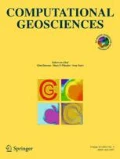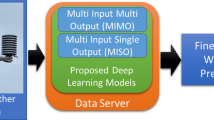Abstract
This paper presents convolutional neural network architectures for integration of dynamic flow response data to reduce the uncertainty in geologic scenarios and calibrate subsurface flow models. The workflow consists of two steps, where in the first step the solution search space is reduced by eliminating unlikely geologic scenarios using distinguishing salient flow data trends. The first step serves as a pre-screening to remove unsupported scenarios from the full model calibration process in the second step. For this purpose, a convolutional neural network (CNN) with a cross-entropy loss function is designed to act as a classifier in predicting the likelihood of each scenario based on the observed flow responses. In the second step, the selected geologic scenarios are used in another CNN with an ℓ2-loss function (as a regression model) to perform model calibration. The regression CNN model (step 2) learns the inverse mapping from the production data space to the low-rank representation of the model realizations within the feasible set. Once the model is trained off-line, a fast feed-forward operation on the observed historical production data (input) is used to reconstruct a calibrated model. The presented approach offers an opportunity to utilize flow data in identifying plausible geologic scenarios, results in an off-line implementation that is conveniently parallellizable, and can generate calibrated models in real time, i.e., upon availability of data and without in-depth technical expertise about model calibration. Several synthetic Gaussian and non-Gaussian examples are used to evaluate the performance of the method.
Similar content being viewed by others
References
Araya-Polo, M., Jennings, J., Adler, A., Dahlke, T.: Deep-learning tomography. Lead. Edge 37(1), 58–66 (2018)
Bassamzadeh, N., Ghanem, R.: Probabilistic Data-Driven Prediction of Wellbore Signatures in High-Dimensional Data Using Bayesian. Networks Society of Petroleum Engineers (2018)
Bond, C. E., Gibbs, A. D., Shipton, Z. K., Jones, S.: What do you think this is?: “Conceptual uncertainty” in geoscience interpretation. GSA Today 17, 4–10 (2007)
Brunetti, C., Bianchi, M., Pirot, G., Linde, N.: Hydrogeological model selection among complex spatial priors. Water Resour. Res. 55(8), 6729–6753 (2019). https://doi.org/10.1029/2019WR024840
Cherpeau, N., Caumon, G., Caers, J., Lévy, B.: Method for stochastic inverse modeling of fault geometry and connectivity using flow data. Math. Geosci. 44(2), 147–168 (Feb 2012)
Demyanov, V., Arnold, D., Rojas, T., Christie, M.: Uncertainty quantification in reservoir prediction part 2—handling uncertainty in the geological scenario. Math. Geosci. 51(2), 241–264 (2019)
Dromgoole, P., Speers, R.: Managing uncertainty in oilfield reserves. Middle East Well Eval. Rev. 12, 30–41 (1992)
Friedmann, F., Chawathe, A., Larue, D. K.: Assessing Uncertainty in Channelized Reservoirs Using Experimental Designs. Society of Petroleum Engineers (2001)
Gavalas, G. R., Shah, P. C., Seinfeld, J. H.: Reservoir History Matching by Bayesian Estimation. Society of Petroleum Engineers (1976)
Golmohammadi, A., Jafarpour, B.: Simultaneous geologic scenario identification and flow model calibration with group-sparsity formulations. Adv. Water Resour. 92, 208–227 (2016)
Goodfellow, I., Bengio, Y., Courville, A.: Deep Learning. MIT Press, Cambridge (2016)
Hermans, T., Nguyen, F., Caers, J.: Uncertainty in training image-based inversion of hydraulic head data constrained to ERT data Workflow and case study. Water Resour. Res. 51, 5332–5352 (2015)
Jacquard, P.: Permeability Distribution from Field Pressure Data. Society of Petroleum Engineers (1965)
Jahns, H. O.: A Rapid Method for Obtaining a Two-Dimensional Reservoir Description from Well Pressure Response Data. Society of Petroleum Engineers (1966)
Jeong, H., Sun, A. Y., Lee, J., Min, B.: A learning-based data-driven forecast approach for predicting future reservoir performance. Adv. Water Resour. 118, 95–109 (2018). ISSN 0309-1708. https://doi.org/10.1016/j.advwatres.2018.05.015
Jiang, A., Jafarpour, B.: Combining Regularized Convolutional Neural Networks with Production Data Integration for Geologic Scenario Selection. SPE Annual Technical Conference and Exhibition (2019)
Jiang, R., Stern, D., Halsey, T., Manzocchi, T.: Scenario discovery workflow for robust petroleum reservoir development under uncertainty. International Journal for Uncertainty Quantification, 6 (2016)
Khaninezhad, M. R., Jafarpour, B.: Prior model identification during subsurface flow data integration with adaptive sparse representation techniques. Comput. Geosci. 18(1), 3–16 (2014)
Khaninezhad, M. R., Jafarpour, B., Li, L.: Sparse geologic dictionaries for subsurface flow model calibration: part I. Inversion formulation. Adv. Water Resour. 39, 106–121 (2012)
Khodabakhshi, M., Jafarpour, B.: A Bayesian mixture-modeling approach for flow-conditioned multiple-point statistical facies simulation from uncertain training images. Water Resour. Res. 49(1), 328–342 (2013)
Kim, S., Min, B., Kwon, S., Chu, M.: History Matching of a Channelized Reservoir Using a Serial Denoising Autoencoder Integrated with ES-MDA. Geofluids. https://doi.org/10.1155/2019/3280961 (2019)
Kingma, D. P., Adam, J. B. a.: A Method for Stochastic Optimization. arXiv.org (2014)
Krizhevsky, A., Sutskever, I., Hinton, G. E.: Imagenet classification with deep convolutional neural networks. Adv. Neural Inf. Process. Syst. 25, 1097–1105 (2012)
Laloy, E., Hérault, R., Jacques, D., Linde, N.: Training-image based geostatistical inversion using a spatial generative adversarial neural network. Water Resour. Res. 54(1), 381–406 (2018). https://doi.org/10.1002/2017WR022148
LeCun, Y., Bengio, Y.: The Handbook of Brain Theory and Neural Networks. MIT Press, Cambridge (1998)
LeCun, Y., Bengio, Y., Hinton, G. E.: Deep learning. Nature 521, 436–444 (2015)
LeCun, Y., Bottou, L., Bengio, Y., Haffner, P.: Gradient-based learning applied to document recognition. In: Proceedings of the IEEE, pp. 2278–2324 (1998)
Leite, E. P., Vidal, A. C.: 3D Porosity prediction from seismic inversion and neural networks. Comput. Geosci. 37(8), 1174–1180 (2011)
Maschio, C., Schiozer, D. S.: Bayesian history matching using artificial neural network and Markov chain Monte Carlo. J. Pet. Sci. Eng. 123, 62–71 (2014)
Min, B., Park, C., Kang, J., Park, H., Jang, I. S.: Optimal well placement based on artificial neural network incorporating the productivity potential. Energy Sources Part A Recov. Utilization Enviro. Effect. 33, 1726–1738,07 (2011). https://doi.org/10.1080/15567030903468569
Mishkin, D., Sergievskiy, N., Matas, J.: Systematic evaluation of CNN advances on the ImageNet. coRR (2016)
Mohaghegh, S. D.: Reservoir simulation and modeling based on artificial intelligence and data mining (AI&DM). J. Natur. Gas Sci. Eng. 3(6), 697–705 (2011)
Nair, V., Hinton, G. E.: Rectified Linear Units Improve Restricted Boltzmann Machines. In: Proceedings of the 27Th International Conference on on Machine Learning, pp. 807–814, Omnipress (2010)
Narayanan, H., Mitter, S.: Sample complexity of testing the manifold hypothesis. Adv. Neural Inf. Process. Syst. 23, 1786–1794 (2010)
Nelson, P. H.: Permeability-porosity Relationships In Sedimentary Rocks. The Log Analyst - Society of Petrophysicists and Well-Log Analysts, pp. 38–62 (1994)
Oliver, D. S., Chen, Y.: Recent progress on reservoir history matching: a review. Comput. Geosci. 15(1), 185–221 (2011)
Park, H., Scheidt, C., Fenwick, D., Boucher, A., Caers, J.: History matching and uncertainty quantification of facies models with multiple geological interpretations. Comput. Geosci. 17(4), 609–621 (2013)
Pirot, G., Huber, E., Irving, J., Linde, N.: Reduction of conceptual model uncertainty using ground-penetrating radar profiles: field-demonstration for a braided-river aquifer, vol. 571. ISSN 0022-1694. note= 10.1016/j.jhydrol.2019.01.047, (2019)
Pirot, G., Renard, P., Huber, E., Straubhaar, J., Huggenberger, P.: Influence of conceptual model uncertainty on contaminant transport forecasting in braided river aquifers, vol. 531. ISSN 0022-1694. https://doi.org/10.1016/j.jhydrol.2015.07.036 (2015)
Posamentier, H. W., Allen, G. P.: Overview: Siliciclastic Sequence Stratigraphy, Concepts and Applications. SEPM Society for Sedimentary Geology (1999)
Randle, C. H., Bond, C. E., Lark, R. M., Monaghan, A.A.: Uncertainty in geological interpretations effectiveness of expert elicitations. Geosphere 15(1), 108–118 (2019)
Roth, G., Tarantola, A.: Neural networks and inversion of seismic data. J. Geophys. Res. Solid Earth 99 (B4), 6753–6768 (1994)
Scheidt, C., Jeong, C., Mukerji, T., Caers, J.: Probabilistic falsification of prior geologic uncertainty with seismic amplitude data application to a turbidite reservoir case. Geophysics 80, 89–100 (2015)
Scholz, M., Fraunholz, M., J. Selbig.: Nonlinear Principal Component Neural Network Models and Applications. Principal Manifolds for Data Visualization and Dimension Reduction. Springer, Berlin (2008)
Schuetter, J., Mishra, S., Zhong, M., LaFollette, R.: A Data-Analytics Tutorial, Building Predictive Models for Oil Production in an Unconventional Shale Reservoir. Society of Petroleum Engineers (2018)
Srivastava, N., Hinton, G., Krizhevsky, A., Sutskever, I., Salakhutdinov, R.: Dropout: a simple way to prevent neural networks from overfitting. J. Mach. Learn. Res. 15, 1929–1958 (2014)
Szegedy, C., Vanhoucke, V., Ioffe, S., Shlens, J., Wojna, Z.: Rethinking the Inception Architecture for Computer Vision. CoRR (2015)
Tarantola, A.: Popper, Bayes and the inverse problem. Nat. Phys. 2, 492–494 (2006)
Van Wagoner, J. C., Posamentier, H. W., Mitchum, R. M., Vail, P. R., Sarg, J. F., Loutit, T. S., Hardenbol, J.: An Overview of the Fundamentals of Sequence Stratigraphy and Key Definitions. In: Sea-Level Changes: an Integrated Approach. SEPM Society for Sedimentary Geology (1988)
Funding
This research was supported in part by a grant from the Energi Simulation Foundation.
Author information
Authors and Affiliations
Corresponding author
Additional information
Publisher’s note
Springer Nature remains neutral with regard to jurisdictional claims in published maps and institutional affiliations.
Rights and permissions
About this article
Cite this article
Mohd Razak, S., Jafarpour, B. Convolutional neural networks (CNN) for feature-based model calibration under uncertain geologic scenarios. Comput Geosci 24, 1625–1649 (2020). https://doi.org/10.1007/s10596-020-09971-4
Received:
Accepted:
Published:
Issue Date:
DOI: https://doi.org/10.1007/s10596-020-09971-4




